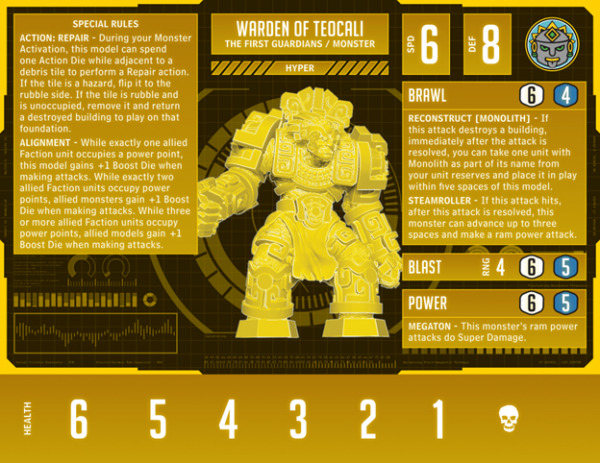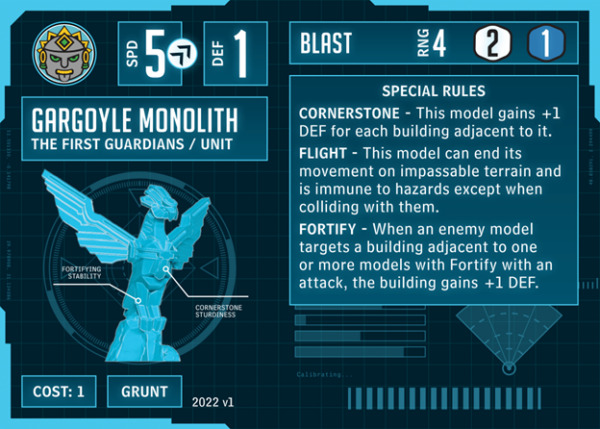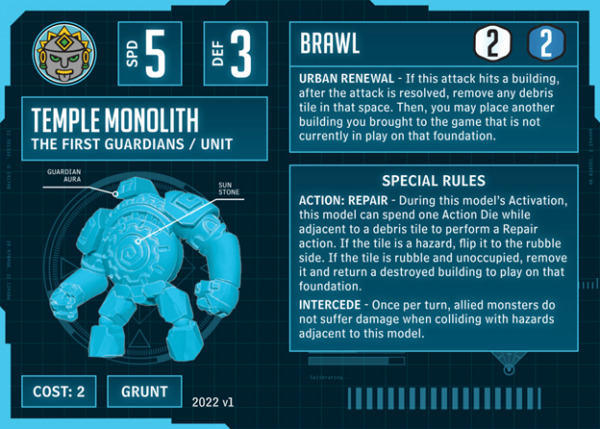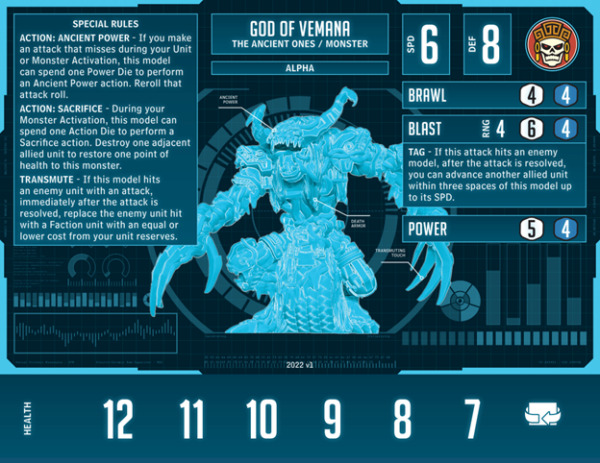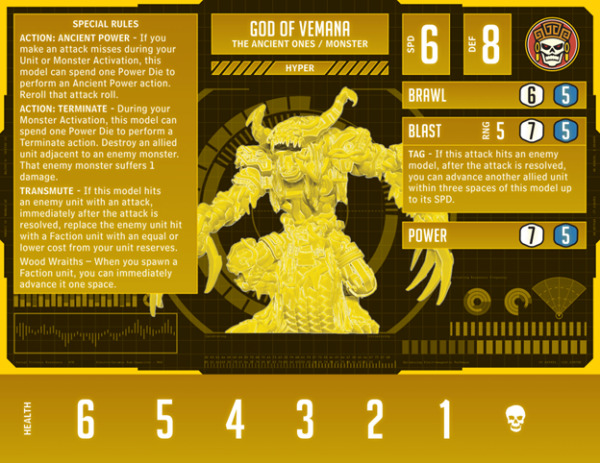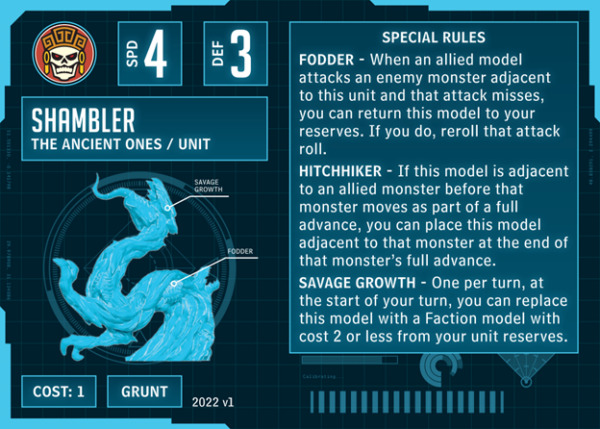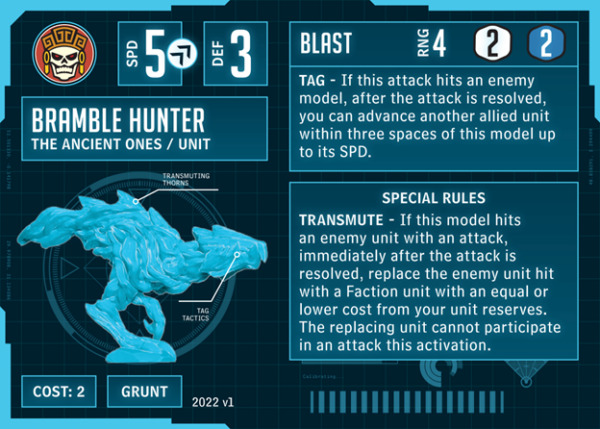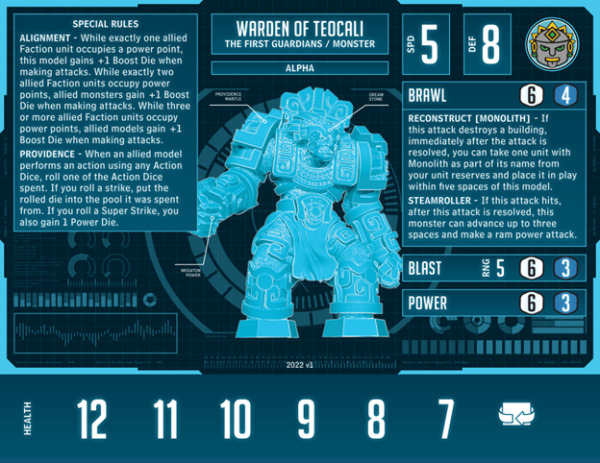
Monsterpocalypse: June Releases Preview
by Emanuel Class
Hello, everyone, and welcome back to another Monsterpocalypse Insider! This week, we’re going to look at the third installment of the First Guardian and Ancient Ones Factions, as well as the last chapter in their story.
For those who have not been following the fiction, let’s catch you up on the God War…
In the beginning, the people of Xoltol prayed to the sky god for favorable seasons. Seeing his people were good, he granted them favorable rains and winds for their crops. Yet the neighboring kingdom of Camazotz did not receive this boon. Their land was harsh and unfavorable for crops, so they survived by hunting…and by raiding other lands. The King of Camazotz sought out the Ancient Altar, a magical shrine that required a great sacrifice to bestow its dark power. The altar transformed Camazotz into a giant bat-like demon and, with that transformation, the destructive power of the god of carnage. The empowered king turned his own people into monstrous creatures of the night and brought his army to bear on the people of Xoltol.
The Master of Xoltol came down from his palace in the clouds to fight for the people he favored. The clash of these titans ravaged the city and forced the Master of Xoltol to transform the people of his land who were willing to fight by his side into creatures of the spirit and of the earth. The Queen of Iximqui, the capital city of Xoltol, could not sit idly by and watch the gods fight over the fate of her people, so she united her people in a common cause. She asked the greatest minds to engineer for her a weapon that could kill a god. They gave her a spear with the power of lightning, and her greatest priest imbued her with the power of the very sun itself.
United with the Master of Xoltol, they drove the King of Camazotz from their land. But he would not stay away for long. He knew that he, too, would need an ally in order to turn the tide of the God War back in his favor.
Enter the Lord of Mictal.
Mictal, the city of the dead in the underworld.
This God of Death agreed to join Camazotz under the condition that the King deliver the heart of the Queen of Ixmiqui to him, for a mortal turned god was irresistible to him. With the forces of death and darkness at their disposal, they renewed the siege of the Land of Xoltol. The fight had cataclysmic consequences. The Lord of Mictal’s desire for the Queen of Ixmiqui drove him to break rank and pursue her to her city’s gates. The Queen had the power of a god but was still learning how to wield it, and while desperately fighting off the Lord of Mictal, she tore open a massive fissure in the ground with her lightning. From that chasm crawled the God of Vemana. The angered spirit of the Earth Mother set her sights on the Queen of Ixmiqui, who radiated unnatural power stolen from the elements of the sun and lightning. Vemana struck the queen like a landslide, knocking her unconscious—and vulnerable. The Master of Xoltol was able to break away from a battle with the King of Camazotzjust long enough to intervene and save the Queen from having her heart removed by the Lord of Mictal.
Yet while she slept, the Queen dreamed of a way to stop the God War. When she awoke, she rushed to the city temple and crafted the dream stone, for she knew the only way to trap a god was to imprison that god in a world they could never destroy: the Dream World. Around her, the stones of the temple began to take the shape of the monolith in her dream, the guardian at the gate of reality. She placed the dream stone on his forehead, and the Warden of Teocali sprang to life. Around them, ley lines of light danced across the city and out into the roiling war beyond. Then, in a flash of light, they were all gone. The First Guardians, the Ancient Ones, the people and the gods alike, they all vanished.
That catches you up on what we know so far. So, what happens next?
Inside the dream stone, the First Guardians and Ancient Ones continued their war for eons. Time passed, and the war seemed like it would be at a stalemate forever. Then something strange happened. The dream world of men began to develop cracks in it. The sky looked like a tapestry of aurora, like lightning. On the other side of the veil, time continued to pass. Invaders from other higher dimensions, alternate realities, and places unimaginable to the mortal mind crossed space and time to create a tear in the world of dreams. Waking nightmares of wars against and alongside kaiju pressed the boundaries of mankind’s sanity. The apex event created such a massive rip in reality that it could be seen like a beacon on the other side of the veil.
It was the God of Vemana who hatched the plan to escape.
They would mount a full assault against the area of the dream world with the greatest, most vulnerable crack. With their divine power, they would force the crack open and return to the world they had been removed from. The First Guardians did everything they could to stop this, but in the end, the barrier between worlds proved to be even more fragile than any of them had imagined. The barrier shattered, and the gods and their armies came tumbling back into reality. The modern world was loud and hostile to these ancient beings warped from eons of war in the dream world, and the First Guardians struggled to convince anyone they were not the enemy, as they bore similarities to the Ancient Ones that immediately set out to conquer the modern world—and they began by making allies with the dark and nefarious monstrosities whose siege enabled their escape in the first place. It was only through their deeds that the First Guardians established themselves as protectors and allies of the modern heroes fighting for the planet’s survival.
So, let’s do the time warp again! Now that you know the backstory and how they got into the modern world, we can get to the reason you are all here. And for everyone who skipped straight to the cards, well, here you go!
The First Guardians’ walking temple is a powerhouse that rewards you for good board position and careful planning. As a SPD 5 pedestrian with only 8 DEF, the Warden is every bit the chunk of rock you think he is; further inspection of his Boost Dice will also tell you that this monster got some of the worst alpha stats in the game. Also a challenge, Teocali also has a very long alpha time, with 6 of his 12 health on the front of his card. He does, however, have a LOT going on in special rules to bring that kit in line. First up, his ability Alignment: this ability may seem like a lot of text, but it is a rule you rarely need to reference once you get the hang of how it works. Alignment grants Teocali +1 Boost Die on his attack rolls if one Faction unit is occupying a power point. If you have two Faction units occupying power points, your allied monsters gain +1 Boost Die. And if you have three or more Faction units occupying power points, all of your models gain +1 Boost Die. This ability does not stack with the previous steps. Some important tools will help the Warden of Teocali archive Alignment—Jaguar Spirits have the ability Flash that can help them jump onto a power point if they make an attack. Arbiter Monoliths can use Ley Line on a Unit or Monster turn to hop onto a power point and also offer super damage with Death Sentence. With Amplify and Def 3, they love to be on power points anyway! Humming Bird Spirits can use their Transpose ability as well to swap one of your opponent’s units off the power point and one of yours onto it. Then, once you have achieved the full alignment, the Temple Giant can swing its axe Judgment for 4 Boost Dice on its Cleave attack.
The triggered effect on Warden of Teocali’s brawl attack Reconstruct [Monolith] can also help the Warden achieve alignment. If the Warden’s brawl attack destroys a building, you may take a unit with [Monolith] in the name and place it into play within five spaces of the Warden. (He basically animates the stone to become a monolith.) Things get really crazy when you chain that five-space placement with the Arbiter Monolith’s action Ley Line. Chain that with a Flicker from the Queen of Ixmiqui, and you can have an Arbiter Monolith jump from the back of the table up to the other side.
The Warden of Teocali also has Steamroller on his brawl attack. After the attack is resolved, the Warden can advance three spaces and make a Ram power attack. This helps set up his one-two punch to topple buildings, build up power, and get alignment going so that his ally monsters can fulfill their destiny, whatever that may be.
The last rule on the Warden of Teocali’s alpha is a whopper. Providence may be one of my favorite abilities in the game. If one of your models makes an action, you may roll the Action Die used to pay for that action, and if the result is a strike, you get to return that die to the well it was spent from. If it’s a super strike, you also gain a Power Die from it. Some of the most impressive lines of play in the First Guardians’ arsenal are when you can chain several actions together, the culmination giving you some extra Action Dice to throw at that clutch attack at the end of a really fun turn. But I have had games where I never got a single strike on my action rolls and some when I didn’t need it. While fun, its wild and unpredictable nature makes it a nice bonus to have but doesn’t necessarily change the flow of the game.
In hyper, the Warden of Teocali loses Providence and his blast attack goes down from 5 to 4 range. However, he keeps Alignment, Reconstruct, and Steamroller. He also goes up to Speed 6 and gains a significant increase in Boost Dice accuracy on his blast and power attacks. Plus, he picks up two new abilities in hyper as well.
Megaton causes the Warden’s ram power attacks to deal Super Damage, which synergizes well with the Warden’s triggered ability, Steamroller. The Warden of Teocali also gains Action Repair, and the ability to return damage sources to the table is very strong. When you combine that with the First Guardians’ building—the World Clock has the ability Rise of Civilization—then the Warden can bring a destroyed building back from a pile of burning rubble just to smash the enemy back into it again. One of the funniest combinations of abilities in the Faction combines the Warden of Teocali’s hyper and that of the Master of Xoltol’s: the Master can Body Slam an enemy into a building and then trigger Ravage and Drag to reposition both himself and the enemy monster in a way that does not block the rubble tile. Then, the Warden of Teocali can use Repair to rebuild the building the enemy was smashed into and then smash them into that same building again!
Our giant temple monster wouldn’t be complete without some new Monolith units to command. Let’s take a look at the Gargoyle Monolith first.
These adorable flying statues test the boundaries of what a defensive unit can do. With Speed 5 and Flight, they are moderately mobile, but DEF 1 makes them brittle. Their ability Cornerstone helps make up for that weak DEF by gaining +1 DEF for each building the unit is adjacent to. This can stack up to some pretty sturdy defense on some maps. Their other ability of note is Fortify, which grants +1 DEF to a building they are hanging out around; this is a good way to help shore up the World Clock’s low defense. As they hang back, they can also use their range 4 blast attack to contribute to the fight farther up the field.
Next up, we have the Temple Monolith. This chonky two-cost unit does a lot of neat things for its high price tag. At Speed 5 and DEF 3, it has respectable stats, and with a two-boost brawl attack, it can take a swing at higher defense targets as well. On its brawl attack, the Temple Monolith has the ability Urban Renewal: if this model’s attack destroys a building, you can replace the debris tile with another building you brought to the game that’s not already in play. This can be a great way to help sift out some of the junk in your back lines. And if the building’s already destroyed, that’s okay, too. With Action: Repair, this Monolith can help restore your buildings to their former glory. Combine that with the World Clock, and this unit can have buildings springing back to life from the ashes of destruction. Since they are going to be hanging out around buildings so much anyway, they also have a last ability that helps every list they’re included in. Intercede says, once per turn, allied monsters do not suffer damage when colliding with hazards adjacent to the Temple Monolith.
If all this goody-good Protectors stuff is not for you, we have that in hand: we have Destroyers in this Insider as well. The God of Vemana is aptly named—its name translates to “God of Sacrifice,” and that is, indeed, what this monster is all about.
Vemana weighs in with average stats across the board: Speed 6, DEF 8, and 4 Boost Dice on every attack. She is also a 12 health pedestrian, with 6 of her health in alpha. But with Action: Sacrifice, she can also live in alpha for a very long time. Vemana has a really interesting combo with her ability Transmute (that lets her turn enemy units she hits into Faction units from your reserve) and her blast attack that can shoot an enemy unit before turning it into one of her own units. Then she can use Tag to move that unit into the perfect spot to be useful screening her by, say, sitting on a power point. Or sometimes it can just serve as a snack for Vemana to Sacrifice (or should I say “snackrifice”). She also boasts the Vegetyrants’ Action: Ancient Power, allowing her or her allies to reroll attack rolls at the cost of a Power Die. The God of Vemana also has some sneaky efficiency built into her kit. As she Transmutes units into play, Vemana can keep them around with the Lake Witches’ ability Dark Ritual. Here is where things get sneaky: since Vemana’s Sacrifice specifies that the sacrificed unit is destroyed, not returned to your reserves. The Lake Witches’ Dark Ritual triggers on “destroyed.” This allows you to Tag a unit, draw it in to eat it, then revive it next to a Lake Witch, ideally to screen her from reprisal.
Vemana’s hyper stays consistent, which is what you want out of strong support monster. She keeps Transmute and Ancient Power; her Boost Dice increase; and her stats stay the same. She gains the ability Wood Wraiths, which is one of the best abilities for any unit general. It’s very simple: when you spawn a Faction unit, you can immediately advance it one space. This can allow you some fast-paced aggression for your fighting units as well as allow you easier securing moves in the late game when dice can be tight. Vemana loses Sacrifice in hyper but gains a variant of it called Terminate. Instead of destroying a unit next to her in order to gain a health back, it instead destroys a unit adjacent to an enemy monster to cause them to suffer 1 point of damage. This is also an effect that destroys the unit, allowing you to save it with a Lake Witch.
This monster is really a love letter to players who want to play Faction-pure or close to it. The God of Vemana plays well with the King of Camazotz, who can also place a unit into play with his brawl attacks. She particularly shines when paired with the Lord of Mictal—given all of her unit tricks, she can help protect the Lord of Mictal, and Ancient Power is exactly what the attack-heavy monsters of this Faction need. When she’s combined with Camazotz, the two of them can dig into their abilities to heal and play defense and grind their opponents to dust. Vemana also helps make up for the Lord of Mictal’s smaller health pool and short but aggressive hyper with her impressive sturdiness and ability to bunker up. No matter how you split it, the God of Vemana makes a great addition to any Destroyers team.
Joining the fray with Vemana are her children. These sinister sentient plants thirst for blood and the destruction of civilization. They also serve as the final piece to the Ancient Ones puzzle, and thus they bring a lot of utility and tricks to the fight.
Shamblers themselves are unimposing with no real noteworthy attack to speak of. With speed 4, these angry vines rely on their ability Hitchhiker to get around. But monsters do not mind having them around, because at DEF 3, these things make great monster screens. With their ability Fodder, they can also offer a reroll at the expense of their own lives. Think of it like Death Sentence, but it grants a reroll instead of Super Damage. Lastly, they have Savage Growth. Once per turn at the start of the turn, one of your Shamblers can replace itself with and of your Faction models with cost 2 or less. This helps get units where you want them when you need them.
Brining up the caboose of this Insider is the Bramble Hunters. These velociraptor-like vine creatures are no joke. For a 2 cost, they clock in at speed 5, DEF 3, and a range 4 blast attack with two Boost Dice on it. Spraying its enemies with a shower of thorns, it can Transmute them into a Faction unit of equal or lower cost. It can then trigger its ability Tag and move the unit it just brought into play or another nearby unit into a more relevant position. One of my favorite plays with them is to shoot something that cost 1 and Transmute it into a Shambler. Then, I can use Tag to move it near my monster so it can Hitchhike with my monster and be ready to offer a reroll with Fodder. If I don’t need the reroll, I can instead Savage Growth it into a Bramble Hunter and start the cycle all over again.
Well, everyone, this concludes the First Guardians and Ancient Ones chapter for now, but who can say what other ancient mysteries and monsters might be hiding just across the veil, waiting to get free? (Well, I guess I could say but not this time!)
The post Monsterpocalypse: June Releases Preview appeared first on Privateer Press.

